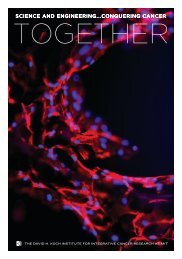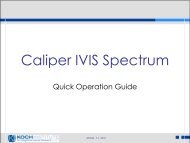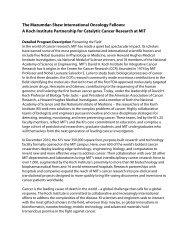Aurora's Guide to Mouse Colony Management
Aurora's Guide to Mouse Colony Management
Aurora's Guide to Mouse Colony Management
Create successful ePaper yourself
Turn your PDF publications into a flip-book with our unique Google optimized e-Paper software.
<strong>Mouse</strong> Breeding Basics<br />
Sexual maturity (puberty): 4 <strong>to</strong> 7 weeks *<br />
Estrous cycle for female fertility: 4 <strong>to</strong> 5 days*<br />
Duration of estrous (peak fertility): 12 hours during the dark (overnight) part of each day<br />
Ovulation: 2 <strong>to</strong> 3 hours after the onset of estrous<br />
Gestation: 19 <strong>to</strong> 21 days*<br />
Average litter size: 4 <strong>to</strong> 12* pups<br />
Breeding lifespan: 6 <strong>to</strong> 12 months<br />
Lifespan: 1 <strong>to</strong> 3 years<br />
Weaning: 21 days*<br />
* = Values can vary with mouse s<strong>to</strong>ck or strain<br />
Breeding Systems<br />
Backcrossing – Breeding of successive offspring <strong>to</strong> pure (wildtype) mice generation<br />
after generation so that your mutation or phenotype is on a “pure” background.<br />
Backgrounds are not pure unless 20 generations of backcrossing has occurred. For<br />
example, each new generation of mice is bred <strong>to</strong> a pure C57B6 mouse.<br />
Cross Breeding - The mating of animals of different breeds or strains,<br />
Also called "hybrid cross."<br />
Inbreeding - Brother/sister or parent/offspring matings for a minimum of 20 generations.<br />
This type of system is used <strong>to</strong> produce animals that are very genetically similar.<br />
The reproductive performance and behaviors can vary depending on the strain.<br />
Line Breeding - In this system, the mating of animals by specific genotype or trait is<br />
performed. This is usually done <strong>to</strong> propagate mutant or transgenic lines, or<br />
because the trait is needed for research.<br />
Monogamous - One male and one female are selected and paired <strong>to</strong>gether for the<br />
duration of their breeding life. This system simplifies record keeping and lends<br />
itself well <strong>to</strong> maintaining inbred or outbred colonies.<br />
Outbreeding - Also referred <strong>to</strong> as random breeding, this system avoids the mating of<br />
close relatives and produces the maximal amount of genetic heterogeneity and<br />
large litters. Animals of different lines of the same s<strong>to</strong>ck are mated, producing a<br />
more vigorous animal by maintaining genetic diversity. Accurate records are<br />
necessary in order <strong>to</strong> prevent breeding animals that are related <strong>to</strong> each other.<br />
Polygamous - Also referred <strong>to</strong> as harem breeding, it is a system where one male is<br />
housed with two or more females (keeping in mind mouse housing density and<br />
overcrowding guidelines). This system results in the large number of young from<br />
the least number of breeding animals. It is the most economical method of<br />
labora<strong>to</strong>ry animal production.<br />
3





